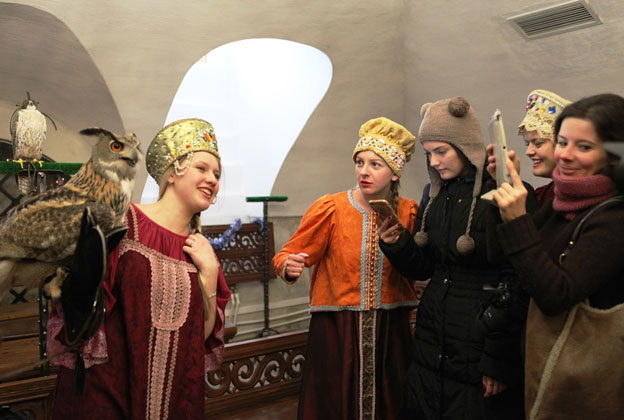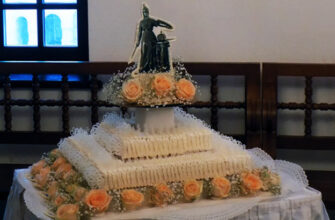Those people who have the opportunity to take a hunting trip accross Russia, or Eastern counties, or visit shows with birds in France, Germany, Austria… you know how exciting it is and, at the same time, how much understanding of nature it gives.
Once, even before Peter I, on the territory of modern Moscow there was constant falconry. Still some areas of the city – for example, Sokolniki or Sokolinaya Gora – keep the memories of it. In the capital today there is a place where you can see a Royal Falcon yard – it is the Association of Moscow state Museum-reserve Kolomenskoe (short of MGOMZ). And, moreover, the young visitors from 6 to 16 years old can dive into this subject with “the king’s courtyard in Kolomenskoye and hunting birds”.
Olga Kucherenkova, the head of tours and art programmes of the Moscow state United Museum-reserve, as well as the Creator of the mentioned program, told the readers of “E-Vesti” what opportunities are opened to Moscow kids today.
E-Vesti: How happened mastering the skills of falconry at the Russian Royal court?
Kucherenkova O.: In ancient times, Kolomenskoye was one of the most convenient places for falconry due to the abundance of its water-meadows and fields, framed by big natural forests; it has become a favorite place of Tsar Alexei Mikhailovich, where he, the contemplative by nature, indulged in the “red fun” – the hunt with falcons, that mostly revered the beauty of flying and training birds.
The Royal children acquire the skills of communication and falconry in practice. He took them hunting, they watched the extraordinary spectacle, and then hunted themselves. Birds were prepared by specially trained people: Falconer, his adjoint, and Sokolniki (those who cared of birds). For example, the tsarevitch Alexei hunted with the falcons in Kolomenskoye together with his father – Tsar Mikhail, the first Romanov. He fell in love with hunting with all his heart. He even wrote a book “Constable way of falcon.” But his son – the future Emperor Peter the Great, whose father died when Prince Peter was still very young, he felt no love of the hunt. Tsar Alexei did not manage to convey his love for falconry.
E-Vesti: Hunting today is no less popular than in the old, tsarist times. As far as this topic is of interest to our children and their parents, what is attractive for them?
Kucherenkova O.: Today the places of falconry are limited, and the number of birds, such as the white Falcon, which was the favorite bird of Tsar Alexei, is listed in the Red book. In addition, bird hunting is regulated by the Russian legislation. So, urban children are not familiar with the culture of falconry.
Our program was created in order to, on the one hand, to enable to tell the city boys and girls about the existence of this kind of hunting and its flourishing in Russia in the second half of the XVII century. In those days the issues related to falconry were in charge of the order of Secret Affairs, and falconry was of political importance, and the falcons were included in the list of the most valuable ambassadors ‘ gifts to the East and to the West.
Communication with live birds under the guidance of a Museum expert gives the opportunity to learn the characteristics of each of the 4 birds we feature, and the falconry vocabulary: what is prisada, klobuchar, glove, vabilo, opulence, dovzhyk, swivel. Children will see all this, and then prepare models of birds to hunt on vabilo (simulation of production) – where child can get so much knowledge and skills at the same time?
On the other hand, we were set the unobtrusive task to bring children to an understanding of the most urgent ecological problems of our time.
E-Vesti: How did You get interest in this topic?
Kucherenkova O.: Interest in the topic derives logically from the history of the Royal residence in Kolomenskoye, where, as stated above, was arranged a huge Falcon yard. In addition to daily (sometimes twice a day) visits, the king hunted in Kolomenskoye, the “front” of the Falcon hunting with the crossing of the carriages of the king and princes and others were arranged too, but Queens with the Queen, invited guests participated in hunt on the left Bank of the Moscow river. There were broken tents, and hunting turned into a big and beautiful holiday.
Briefly about the hunt. This is one of the most ancient human activities. Besides the fact that hunting fed a man in primitive times, it woke in him the artistic and literary abilities (a lot of ancient caves keep the image of hunting and wild animals, a lot of epic and fairy stories were written on the theme of hunting), and it raised in the hunter observation, endurance, wisdom, spirituality, took an oath of the future defender of hearth and Fatherland.
At the Russian court in the time of Aleksey Mikhailovich, in 1650 in the villages of Kolomenskoye and the Semenov was established by the sovereign falconry, which contained more than 3,000 birds, brought from the North. Birds – falcons, Merlin falcons, red and white hawks, eagles. They tended to up to 300 people, headed with the Royal Falconer, head of the Royal hunts, and his Deputy. Royal falcons were fed by peasants who carried the “pigeon service” – yard a hundred thousand pigeon nests food was provided by trappers favorites.
The program consists of tours and hands-on interactive part. It is conducted by reservation for organized groups. Details and contacts, see on the Website of the museum.




